| Listing 1 - 10 of 11 | << page >> |
Sort by
|
Book
ISBN: 393694234X 9783936942347 Year: 2003 Publisher: Bonn Monumente Publikationen der Deutshe Denkmalschutz
Abstract | Keywords | Export | Availability | Bookmark
 Loading...
Loading...Choose an application
- Reference Manager
- EndNote
- RefWorks (Direct export to RefWorks)
Architecture, Gothic --- Building, Brick --- Architecture gothique --- Construction en brique --- Hansa towns --- Villes de la Hanse --- Commerce --- History --- Histoire --- 691.4 --- 72.033.5 --- Earth. Cob. Clayware. Stoneware. Ceramic building materials --- Gotische bouwkunst. Architectuur van de late-Middeleeuwen --- 72.033.5 Gotische bouwkunst. Architectuur van de late-Middeleeuwen --- 691.4 Earth. Cob. Clayware. Stoneware. Ceramic building materials
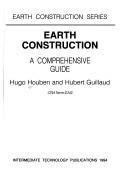
ISBN: 185339193X 9781853391934 Year: 2005 Publisher: Bourton-on Dunsmore ITDG
Abstract | Keywords | Export | Availability | Bookmark
 Loading...
Loading...Choose an application
- Reference Manager
- EndNote
- RefWorks (Direct export to RefWorks)
691.4 --- 691.4 Earth. Cob. Clayware. Stoneware. Ceramic building materials --- Earth. Cob. Clayware. Stoneware. Ceramic building materials --- Earth construction --- Earth houses --- Dwellings --- Domiciles --- Homes --- Houses --- One-family houses --- Residences --- Residential buildings --- Single-family homes --- Buildings --- Architecture, Domestic --- House-raising parties --- Household ecology --- Housing --- Earth lodges --- Earthen houses --- Building, Earth --- Earth building --- Building --- Design and construction --- aarde (bouw) --- architectuur --- Building materials. Building technology --- bouwconstructies --- Architecture --- architecture [discipline] --- structures [single built works] --- Earth construction. --- Construction en terre
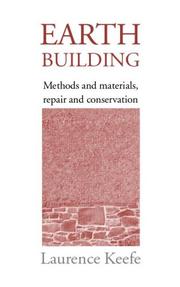
ISBN: 0415323223 Year: 2005 Publisher: London Taylor & Francis
Abstract | Keywords | Export | Availability | Bookmark
 Loading...
Loading...Choose an application
- Reference Manager
- EndNote
- RefWorks (Direct export to RefWorks)
Earth construction --- 691.4 --- 693.3 --- 691.4 Earth. Cob. Clayware. Stoneware. Ceramic building materials --- Earth. Cob. Clayware. Stoneware. Ceramic building materials --- 693.3 Masonry of stabilized earth. Pise_/-de-terre (rammed-earth construction). Cob --- Masonry of stabilized earth. Pise_/-de-terre (rammed-earth construction). Cob --- Building, Earth --- Earth building --- Building --- Building materials. Building technology --- Conservation. Restoration --- Architecture --- technology [general associated concept] --- architectonics --- preserving --- building materials --- bouwtechnologie --- conservatie --- aarde (bouw) --- bouwmaterialen
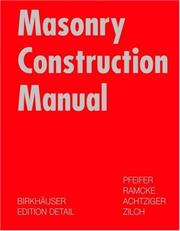
ISBN: 3764365439 9783764365431 Year: 2001 Publisher: Basel : Birkhäuser,
Abstract | Keywords | Export | Availability | Bookmark
 Loading...
Loading...Choose an application
- Reference Manager
- EndNote
- RefWorks (Direct export to RefWorks)
Building materials. Building technology --- brick [clay product] --- metselwerk --- Architecture --- Masonry --- Maçonnerie --- Manuels d'enseignement supérieur --- 691 --- 691.4 --- 693.25 --- 624.012.2 --- Metselwerk ; constructie ; handboeken --- 693(035) --- 693.2 --- Bouwmaterialen (architectuur) --- Baksteen --- Metselwerkconstructies --- Earth. Cob. Clayware. Stoneware. Ceramic building materials --- Masonry of brickwork (burnt bricks) --- Structures in artificial stone. Cast stone masonry --- Metselwerk ; handboeken --- Metselwerk van baksteen --- Baksteenarchitectuur --- Constructieleer --- Materiaalleer --- Metselen --- Baksteenarchitectuur. --- Constructieleer. --- Materiaalleer. --- Metselen. --- 624.012.2 Structures in artificial stone. Cast stone masonry --- 693.25 Masonry of brickwork (burnt bricks) --- 691.4 Earth. Cob. Clayware. Stoneware. Ceramic building materials --- brick [clay material] --- Manuels d'enseignement supérieur. --- Manuels d'enseignement supérieur. --- Masonry - Handbooks, manuals, etc. --- Maçonnerie
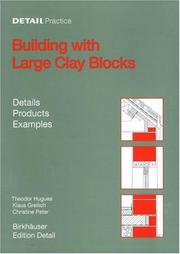
ISBN: 3038212938 3034614659 3764371110 129986371X 9783034614658 Year: 2004 Publisher: Basel : Birkhäuser,
Abstract | Keywords | Export | Availability | Bookmark
 Loading...
Loading...Choose an application
- Reference Manager
- EndNote
- RefWorks (Direct export to RefWorks)
In modern masonry work it is customary to use large size blocks in building. They fulfil all the construction requirements even in singlelayer outside walls. Using two houses as examples all details are presented clearly and comprehensively in a scale of 1:10. In modern masonry work it is customary to use large size blocks in building. They fulfil all the construction requirements even in singlelayer outside walls. Using two houses as examples all details are presented clearly and comprehensively in a scale of 1:10. The authors elucidate on critical points, showing where care should be given to achieve convincing sustainable results.
Masonry. --- Building materials. Building technology --- building materials --- klei --- clay --- bouwmaterialen --- 691 --- 691.4 --- Bouwmaterialen ; baksteen ; grote kleiblokken --- 693.2 --- 693.2 Masonry of treated material, stones, blocks etc. --- Masonry of treated material, stones, blocks etc. --- 691.4 Earth. Cob. Clayware. Stoneware. Ceramic building materials --- Earth. Cob. Clayware. Stoneware. Ceramic building materials --- Bouwmaterialen (architectuur) --- Klei --- Bouwmaterialen ; leem, klei, aardewerk --- Maçonnerie --- Blocs en béton --- Constructions en argile --- Maçonnerie --- Masonry --- Building --- Foundations --- Walls --- Masonry of treated material, stones, blocks etc --- Blocs en béton. --- Constructions en argile. --- Maçonnerie. --- Blocs en béton. --- Maçonnerie.
Book
ISBN: 9782875221100 2875221108 Year: 2013 Volume: 11 Publisher: Namur IPW
Abstract | Keywords | Export | Availability | Bookmark
 Loading...
Loading...Choose an application
- Reference Manager
- EndNote
- RefWorks (Direct export to RefWorks)
Tiles --- Pavements, Tile --- Tile facades --- Tiles in interior decoration --- Floor coverings industry --- Carreaux --- Carrelages --- Façades en céramique --- Carreaux en décoration intérieure --- Revêtements de sol --- History --- Histoire --- Céramique architecturale --- Carreaux de ciment --- 691.4 --- 691.54 --- 693.7 --- Earth. Cob. Clayware. Stoneware. Ceramic building materials --- Cements. Pozzolanic materials --- Floor tiling. Wall tiling. Paving. Paviour's trade. Asphalt work --- 693.7 Floor tiling. Wall tiling. Paving. Paviour's trade. Asphalt work --- 691.54 Cements. Pozzolanic materials --- 691.4 Earth. Cob. Clayware. Stoneware. Ceramic building materials --- Façades en céramique --- Carreaux en décoration intérieure --- Revêtements de sol --- Belgium --- Pavements [Tile ] --- Floor coverings --- History.
Book
ISBN: 9783856763930 3856763937 Year: 2019 Publisher: Zürich: Gta Verlag,
Abstract | Keywords | Export | Availability | Bookmark
 Loading...
Loading...Choose an application
- Reference Manager
- EndNote
- RefWorks (Direct export to RefWorks)
La construction en terre n'est pas seulement l'une des plus anciennes, mais aussi l'une des méthodes de construction les plus modernes de notre époque. Quelles sont les opportunités économiques, écologiques et sociales dans l'utilisation accrue de la terre comme matériau de construction ? Ce volume présente un large éventail de projets construits, ou développés ainsi que de nouvelles stratégies pour réaliser l'architecture en argile - une méthode de construction qui peut être adaptée à n'importe quelle culture et contexte. Les auteurs présentent des innovations technologiques révolutionnaires à l'aide d'exemples impressionnants, illustrant les avantages de ce matériau : de la disponibilité mondiale à la possibilité d'un recyclage complet, de la production climatiquement neutre à une utilisation socialement responsable, notamment dans les pays émergents. (d'ap. l'éditeur) Earth building is not only one of the oldest, but also one of the most modern construction methods of our time. What economic, environmental, and social conditions are necessary for an upscaling of earth to occur? In the future, cement, the most important component of concrete, will - as well as other finite resources - become less viable to produce and significantly more expensive. Considering appropriate alternatives for building materials is becoming imperative. This book presents a wide scope of built and unbuilt projects as well as strategies that can be implemented to edify processes of building, adapting the use of earth to each unique culture and context. Using impressive examples, the authors demonstrate groundbreaking technological innovations that highlight the advantages of this material: from its worldwide availability to the possibility of comprehensive recycling, from climate-neutral production to socially just implementation, including a focus on emerging economies. This book reveals the incredible potentials of earthen architecture - for people and for the entire planet.
Construction en terre --- Constructions en terre --- Construction --- Habitations --- Matériaux --- Aspect environnemental --- Earth construction --- Building materials --- Earth houses --- 691.4 --- Architectuur ; bouwmaterialen ; leem ; ongebakken aarde ; klei --- Ecologische bouwmaterialen --- Architectuur ; materialen ; uit de natuur --- Architectural materials --- Architecture --- Building --- Building supplies --- Buildings --- Construction materials --- Structural materials --- Materials --- Earth lodges --- Earthen houses --- Dwellings --- Building, Earth --- Earth building --- Environmental aspects --- Bouwmaterialen ; leem, klei, aardewerk --- 691 --- Bouwmaterialen (architectuur) --- Materialen (design) --- Aarde --- Leem --- Baksteen --- Construction écologique --- 691.4 Earth. Cob. Clayware. Stoneware. Ceramic building materials --- Earth. Cob. Clayware. Stoneware. Ceramic building materials --- Building materials - Environmental aspects --- Matériaux
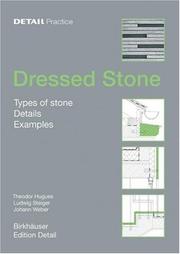
ISBN: 9783764372736 3764372737 1299863728 3034614640 9783034614641 Year: 2012 Publisher: Basel : Birkhäuser,
Abstract | Keywords | Export | Availability | Bookmark
 Loading...
Loading...Choose an application
- Reference Manager
- EndNote
- RefWorks (Direct export to RefWorks)
Der Einsatz von Naturwerkstein hat eine lange Tradition. Der Umgang mit diesem faszinierenden Material stellt jedoch hohe Anforderungen an das handwerkliche Können und stellt Planer und Ausführende vor neue Herausforderungen in neuen Anwendungsbereichen. Dieses Buch möchte hier Abhilfe schaffen: Der Einsatz von Naturstein wird in Detailzeichnungen im Maßstab 1:10 nachvollzogen, wobei besonderer Wert auf alle Anschlusspunkte und die damit verbundenen speziellen Probleme gelegt wird und worauf bei Entwurf und Planung als auch während der Ausführung zu achten ist. Gegenüber der erhältlichen deutschen Ausgabe wurde diese internationale Ausgabe im konstruktiven Teil ergänzt durch ein Kapitel zur Fassadentechnik, und die Steinkarten wurden um eine Auswahl der meistgefragten 80 europäischen Steine erweitert. Handling this traditional but still captivating building material has its quirks, today perhaps more than ever. On the one hand it can no longer be taken for granted that stonemasonry skills will be readily available, while there are also new requirements and applications, not to mention damaging environmental influences, that create uncertainty for planners and implementers. This book is designed to provide assistance. - From cornice to curtain-walling: all details in words and sectional drawings - Are you looking for a particular stone? The most important domestic types of stone with supplier details - Various surface treatments and their visual effect - Documentation of 15 selected example applications
553.5 --- 691.2 --- 691 --- Bouwmaterialen ; natuursteen ; bewerkte oppervlaktebehandeling --- Onderdelen en constructie-elementen van gebouwen --- Bouwmaterialen ; natuursteen ; details --- Gevels ; bewerkte steen --- 692.23 --- natuursteen --- 691.3 --- 691.4 --- 691.5 --- 692 --- Natuursteen (geologie) --- Natuursteen --- Natuursteenconstructies --- Bouwmaterialen (architectuur) --- Constructie-elementen van gebouwen ; buitenmuren, gevels --- bouwmaterialen: natuursteen --- Building materials. Building components --- Natural stones. Other mineral materials --- Artificial stone. Concrete. Various agglomerates --- Earth. Cob. Clayware. Stoneware. Ceramic building materials --- Binders. Bedding materials --- Structural parts and elements of buildings --- 692 Structural parts and elements of buildings --- 691.5 Binders. Bedding materials --- 691.4 Earth. Cob. Clayware. Stoneware. Ceramic building materials --- 691.3 Artificial stone. Concrete. Various agglomerates --- 691.2 Natural stones. Other mineral materials --- 691 Building materials. Building components --- stone [worked rock] --- Architecture --- Building materials. Building technology --- building materials --- bouwmaterialen --- Building, Stone --- Stone building --- Stone construction --- Building --- Building, Stone. --- Masonry. --- Building stones. --- Construction en pierre --- Maçonnerie --- Pierre à bâtir --- Bouwmaterialen ; natuursteen
Book
ISBN: 9780500343579 0500343578 Year: 2020 Publisher: London Thames & Hudson
Abstract | Keywords | Export | Availability | Bookmark
 Loading...
Loading...Choose an application
- Reference Manager
- EndNote
- RefWorks (Direct export to RefWorks)
"For almost 10,000 years man has built in unbaked earth, not only simple dwellings but also palaces, temples and fortresses of the utmost grandeur and durability. This encyclopedic work shows the extreme diversity of this type of architecture from a technical, cultural and historical point of view. After presenting the various types of raw earth constructions (adobe and rammed earth, walls and roofs, columns, etc.), Jean Dethier reveals some of the raw earth masterpieces scattered across five continents, most of which are listed as UNESCO world heritage sites. From the creations of antiquity to those of today, as well as vernacular heritage and modernist works, the book surveys a multitude of building types: monumental structures - the temples and palaces of Mesopotamia, the Great Wall of China, the Great Mosque of Djenné in Mali, Capitagreen in Singapore; large urban developments - the city of Tenochtitlan in Mexico, the medinas of Morocco; housing in Marrakech, Bogota and various European cities; the castle-houses of the Somba people in Togo; Martin Rauch's villas in Austria; and public amenities - sa high school in Bangladesh, a museum in Australia, a market in Koudougou, Burkina-Faso, and many more... The culmination of fifty years of work, this definitive book is illustrated with 600 photographs and about one hundred drawings and architectural plans." [Publisher]
Architecture --- Earth construction --- Monuments --- 72.031.2 --- 691.4 --- Architectuur ; uit aarde ; vroeger en vandaag --- Leemarchitectuur --- Vernaculaire ; traditionele architectuur --- Historical monuments --- Sculpture --- Historic sites --- Memorials --- Public sculpture --- Statues --- Building, Earth --- Earth building --- Building --- Architecture, Western (Western countries) --- Building design --- Buildings --- Construction --- Western architecture (Western countries) --- Art --- History --- Architectuurgeschiedenis ; primitieve en vernaculaire architectuur --- Bouwmaterialen ; leem, klei, aardewerk --- Design and construction --- Architectuur ; geschiedenis --- Bouwmaterialen ; geschiedenis --- Ambachten ; geschiedenis --- Constructions en terre --- Building, Adobe --- Constructions en adobe --- Building, Clay --- Constructions en argile --- Vernacular architecture --- Architecture vernaculaire --- Building materials. Building technology --- vernacular architecture --- loam --- biological material --- History. --- Architecture, Primitive --- 691.4 Earth. Cob. Clayware. Stoneware. Ceramic building materials --- Earth. Cob. Clayware. Stoneware. Ceramic building materials --- 72.031.2 Primitieve bouwkunst --- Primitieve bouwkunst
Book
ISBN: 9789462086555 9462086559 9789462086821 Year: 2021 Publisher: Rotterdam : nai010 uitgevers,
Abstract | Keywords | Export | Availability | Bookmark
 Loading...
Loading...Choose an application
- Reference Manager
- EndNote
- RefWorks (Direct export to RefWorks)
For a long time, the theme of soil – as matter, not as territory – has been the quasi exclusive subject of agriculture, geography and soil science. Only in the last few decades, due to a rapidly growing awareness of climate change, has soil increasingly come into focus in urban design, in particular as a matter that can also provide ecosystem services in urban environments. Inspired by Bernardo Secchi's 1986 text ‘Progetto di Suolo', this issue of OASE makes a critical analysis of how soil – as an intermediary package that connects surface and subsurface – can further connect to the practices of urbanism and urban design, and how it can guide those practices in exploring new agendas. This issue of OASE makes a critical analysis of how soil connects to urban planning and urban design, and how it can adjust those practices in exploring new agendas.
Land use, Urban. --- Soil management. --- Soils --- Underground areas. --- Environmental aspects. --- Urban soils --- City planning --- Urban ecological design --- Cities and towns --- Civic planning --- Land use, Urban --- Model cities --- Redevelopment, Urban --- Slum clearance --- Town planning --- Urban design --- Urban development --- Urban planning --- Land use --- Planning --- Art, Municipal --- Civic improvement --- Regional planning --- Urban policy --- Urban renewal --- Government policy --- Management --- Ecological design, Urban --- Ecological landscape design --- 691.4 --- 711.4 --- 72.504 --- 72.504 Architecture and the environment. Sustainable architecture --- Architecture and the environment. Sustainable architecture --- 711.4 Gemeentelijke planologie. Stadsplanning. Stedenbouw --- Gemeentelijke planologie. Stadsplanning. Stedenbouw --- 691.4 Earth. Cob. Clayware. Stoneware. Ceramic building materials --- Earth. Cob. Clayware. Stoneware. Ceramic building materials --- Environmental planning --- Physical geography --- urban studies --- soil
| Listing 1 - 10 of 11 | << page >> |
Sort by
|

 Search
Search Feedback
Feedback About UniCat
About UniCat  Help
Help News
News